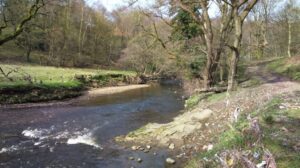
The River Darwen begins on the South Pennine Moors. It then flows through a valley of Carboniferous rocks, including limestone, Millstone Grit, shales and coal, to meet the River Ribble in Preston. The River Darwen has one of the most impressive gorges in Lancashire, known as Hoghton Bottoms. The bedrock is largely covered by glacial and post-glacial deposits of sands, gravels, clays and alluvium. Where the bedrock is exposed at the surface, there is a history of stone quarrying and coal mining.
The Industrial Revolution saw the development and expansion of major settlements, which include Blackburn and Darwen. A small ‘cottage’ cotton and textile industry developed, first drawn to the area for its available water power. The power of the water was harnessed and controlled by the construction of weirs. The textile trade developed rapidly with increased mechanisation, but it has been in steady decline since the 1920s. As a result of industrialisation, the landscape that the River Darwen passes through is now largely urban. The towns are dominated by mills and Victorian-stone terraced housing along with substantial areas of contemporary industrial development.
The population soared to provide labour for these mills and until the invention of sewage treatment works, the sewage from the associated properties ended up in the river. Where the rivers flowed through towns the immediate solution to sewage gathering on the banks of the river in the town was to design and build new river channels that formed flumes to rapidly transport the sewage and other waste away downstream. The significantly increased population of Blackburn also required water, and the construction of abstraction points and aqueducts began, first on the River Hodder. There are now a number of reservoirs in the River Darwen sub-catchment, including Roddlesworth and Sunnyhurst Hey Reservoirs.
The weirs that were built caused fragmentation of rivers and many mills also caused pollution such as from the bleaching and cleaning of wool. As industry developed, paint-works and chemical factories began to appear within the catchment and it was common for the River Darwen to run ‘the colours of the rainbow’ as waste paint and dyes were transported down the river.
Before industrialisation, agriculture was the major source of income. Farmland is now fragmented by industry, roads and housing. Agriculture remains on the edges of the South Pennine Moors.
The impacts of the historical uses and management of the catchment on rivers have been profound, however the rate has gathered significant pace, as the issues have accumulated and intensified as population has continued to grow; new chemicals (agricultural and domestic) have become available and Climate Change has begun to manifest.
There have been improvements and attempts to address these issues over the course of modern history, such as the creation of modern day sewage treatment works, reduction in exploitation of fisheries and the introduction of agri-environment schemes to encourage agricultural practices to help support the environment. More recently, the introduction of the Water Framework Directive has resulted in significant efforts to improve rivers and streams for all. This directive recognises the importance and value of rivers and streams and places the responsibility on countries to improve and upgrade their rivers and streams to ‘good ecological status’.

